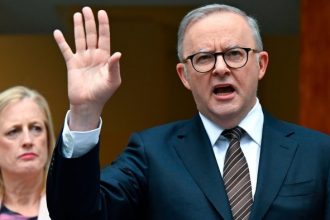By Ann Saphir
(Reuters) -Federal Reserve policymakers have signaled they won’t cut U.S. interest rates just yet; most economists think they will wait until June, given ongoing strength in household spending and uncertainty over the economic outlook.
But U.S. central bankers, who have kept the Fed’s benchmark overnight interest rate in the 5.25%-5.50% range since last July, have already begun the pivot to easier policy.
Price pressures clearly are cooling. The Fed’s preferred measure of inflation – the personal consumption expenditures price index – increased 2.6% in December from a year earlier, the Commerce Department reported on Friday. Underlying inflation, on a six-month and three-month annualized basis, is now running below the central bank’s 2% goal.
Following the release of the data, traders slightly favored the Fed’s April 30-May 1 policy meeting over the March 19-20 meeting as the likely kickoff for a series of rate cuts this year.
Fed officials so far say that progress on inflation is still not enough. But they don’t want rate cuts, when they eventually deliver them, to be a surprise.
“I think of it as turning a battleship,” said Luke Tilley, the chief economist at Wilmington Trust Investment Advisors. “Their communication has gone from being way too hawkish and started to turn to what is more likely to happen and preparing for the start of cuts. The switch takes a while and they are moving in that direction.”
The turn in communications may be yet more evident in the policy statement due to be issued next Wednesday after the end of the central bank’s first Federal Open Market Committee (FOMC) meeting of 2024, and in Fed Chair Jerome Powell’s post-meeting press conference, analysts said.
Here are five ways Fed policymakers have adjusted their steering so far:
FROM ‘PAIN’ TO A ‘GOLDEN PATH’
Policymakers were initially pretty sure their inflation fight would boost the unemployment rate and cause households “pain,” as Powell warned in August 2022.
By mid-2023, unemployment was still well below 4% while inflation had dropped noticeably, and Chicago Fed President Austan Goolsbee began talking up the possibility of finding a “golden path” that skirted economic pain.
Earlier this month, Atlanta Fed President Raphael Bostic adopted the metaphor, and said that progress towards it had led him to pencil in an earlier start to rate cuts than before.
Powell has not used that turn of phrase, though in September he acknowledged the path to a “soft landing,” in which inflation slows without triggering a painful recession or big loss of jobs, may have widened. Fed Governor Christopher Waller said recently the combination of low unemployment and inflation “is almost as good as it gets.”
“We think the FOMC cannot believe its luck that a soft landing is unfolding, and is focused on not screwing this up – either by declaring victory too soon, or, waiting too long to start cutting,” Krishna Guha, vice chairman at Evercore ISI, wrote in a note.
AVOIDING A ‘MISTAKE’
“The biggest mistake we could make is really, to fail to get inflation under control,” Powell said last November.
With inflation falling faster than expected with no further increases in the Fed’s policy rate since July, that word is getting redefined.
“We’re aware of the risk that we would hang on too long,” Powell said last month. “We know that that’s a risk, and we’re very focused on not making that mistake.”
Economists at Citi, Bank of America and a number of other firms said the Fed next week could give itself some added flexibility by dropping the reference to “additional policy firming” that has been included in every post-meeting policy statement since March 2023.
EVEN HAWKS SEE RATE CUTS
In 2023, Fed policymakers were busy either actually delivering rate hikes, or keeping the door open to them.
Fed Governor Michelle Bowman, among the most hawkish of Fed policymakers, early this month said her views have evolved to allow for the possibility that rates may not need to rise further, and that cuts in borrowing costs could be warranted if inflation keeps falling.
Cleveland Fed President Loretta Mester, also hawkish in her outlook, said that the March meeting is “probably” too early for a rate cut, though she, like the majority of her colleagues, sees several rate cuts this year.
Dallas Fed President Lorie Logan this month said easing financial conditions mean a rate increase is still on the table, but she also noted “a lot of progress” toward a more sustainable economy and a gradual rebalancing.
‘BALANCED’ RISKS, AND BALANCING POLICY
Since the start of the current Fed tightening cycle in March 2022, most policymakers were nearly 100% focused on achieving the central bank’s congressionally mandated goal of “price stability.” Toward the end of last year, however, the second plank of the mandate, “maximum employment,” drew increased attention.
“We’ve come back into a better balance between the risk of overdoing it and the risk of underdoing it,” Powell said last month.
San Francisco Fed President Mary Daly last week said risks to both the economy and to policy were “balanced.”
TREADING ‘CAREFULLY’
Policymakers at their last meeting mentioned the likelihood of rate cuts in 2024 but did not delve into when and how fast they would occur, minutes of that meeting showed. Analysts expect a deeper debate next week.
In recent months, Fed policymakers have used a range of modifiers to describe possible approaches: Waller said they should be “carefully calibrated and not rushed,” for instance.
One thing seems clear: rate cuts are likely to follow a very different cadence from the aggressive “front-loading” of rate hikes that included a string of 75-basis-point increases in 2022.
“While we’re certainly entering the ‘rate-cut discussion zone’ and we anticipate this will be the main topic” on the agenda of the Fed’s meeting this month, policymakers will be wary of disinflation bumpiness, Gregory Daco, chief economist at EY, wrote in a note.
Read the full article here





